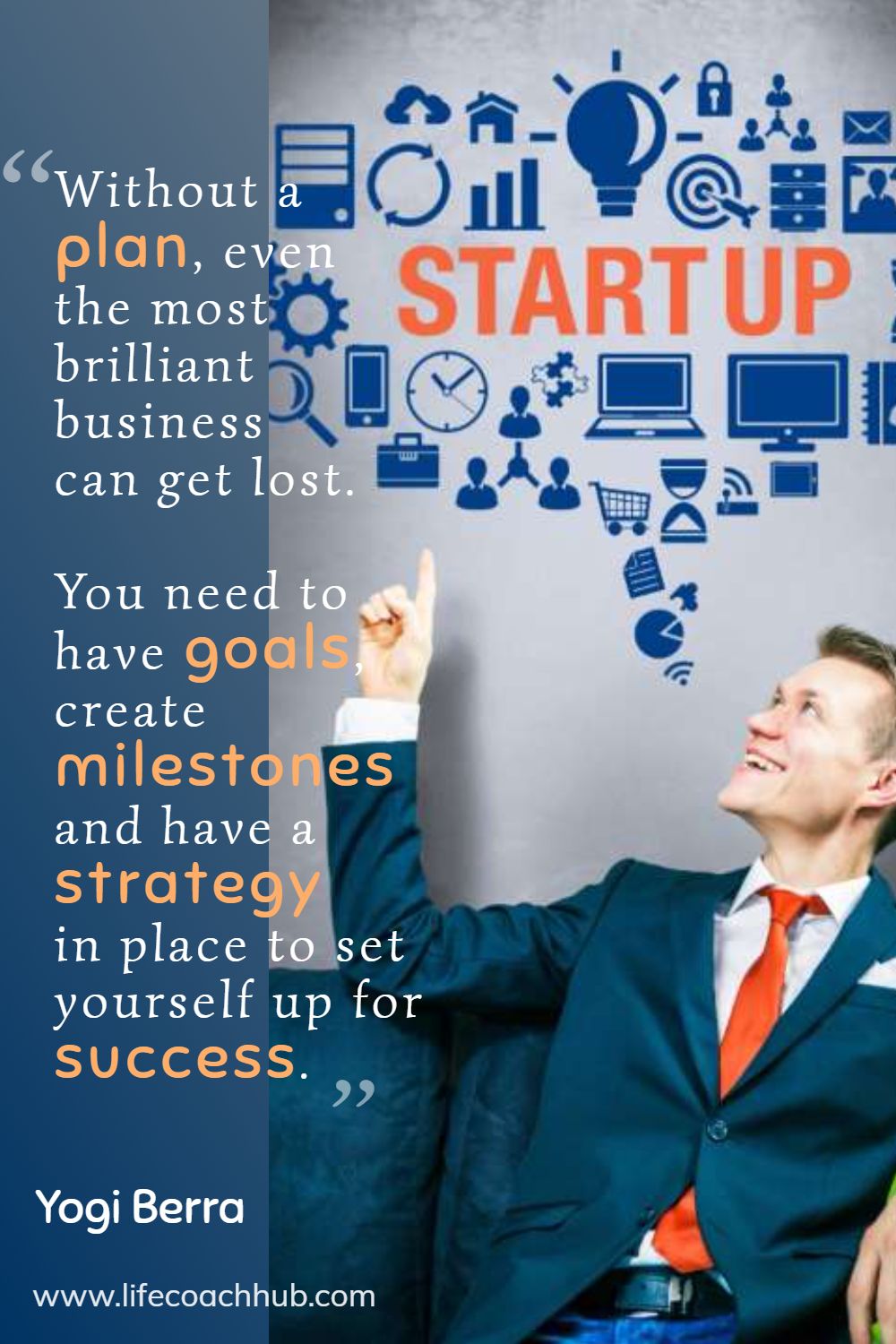
“No one ever told me that starting a business would be this hard!”
Does this statement sound familiar to you? I bet you’ve heard it hundreds of times from someone you know. Or maybe you’ve said it yourself. But you know what? Even those who got their MBA might have felt the same way at some point.
So here’s the deal - you got your certification and trained for months (or years) to be a life coach, and now what? You’re facing another challenge in starting your coaching company.
We get it. As a life coach, the last thing you want is to concern yourself with too much paperwork. I mean, who likes to deal with bureaucracy and everything that comes with registering and managing a business?
We’ve been there.
But we can only plan for today and be ready for what tomorrow may bring. We want you to free yourself from the frustration and overwhelm that you may have. So we’re sharing our hard-earned lessons in starting a life coaching business.
Ready to get started?
Here’s your ultimate guide to jumpstarting your coaching company.
Starting a coaching business checklist: Your 8-point life coaching checklist
#1 Analyze your core
Are you pursuing your vision?

When applying for a job it's common to get the question, “Where do you see yourself 3 to 5 years from now?” I remember I always prepared myself in advance to answer this. So, during the interview, I seemed quite confident, but deep inside, I was super nervous and unsure. I thought, who knows what will happen tomorrow? Not to mention in three years?
Establish your purpose, vision, and mission
Your vision is a snapshot of your future business; it identifies what you want to achieve. At the same time, your mission explains how you will get there.
But now that we’re running a business, we know for sure that having a vision and a goal are crucial. These two essentials set you on the path you chose. You can’t build a business today and decide to stop or change your course by next month!
So, starting now, you need to sit down and think about your purpose, vision, and mission. Why did you choose to be a life coach? Your response to that inquiry is your life’s purpose. In Simon Sinek’s words, your purpose describes “why you do what you do” and more importantly, why you exist.

Your vision is a snapshot of your future business; it identifies what you want to achieve. At the same time, your mission explains how you will get there.
Your vision is something that you aspire to or strive for, and looks far-reaching. While your mission keeps you on track through the elimination of distractions. These two must complement each other to create your path to success.

Here are some tips for writing your vision and mission statements.
- Be ambitious yet realistic
- Be clear yet inspirational
- Be creative and consistent
- Be unique and memorable
Still unsure of how to craft your own vision and mission statements? Draw inspiration from these phenomenal businesses.
- Starbucks
Vision: To establish Starbucks as the primary purveyor of the finest coffee in the world while maintaining our uncompromising principles while we grow.
Mission: To inspire and nurture the human spirit - one person, one cup, and one neighborhood at a time.
- Tesla
Vision: To create the most compelling car company of the 21st century by driving the world’s transition to electric vehicles.
Mission: To accelerate the world’s transition to sustainable energy.
- Netflix
Vision: Becoming the best global entertainment distribution service.
Mission: To entertain the world through best-in-class TV series, documentaries, feature films, and mobile games.
Set SMART goals and follow through with commitment and accountability
To make your vision come to life and become simple to reach, you need to break it down into goals. The way to develop your goals is by identifying concrete steps to achieve them.
Let’s check out how Edwin Locke and Gary Latham, pioneers of goal-setting theory, describe it. They define a goal as a result that an individual aims for. A goal serves as a basis for measuring your performance (Latham & Locke, 1991).
As coaches, we are aware that goals support the success of our clients. Goals lead them to reach specific milestones that draw them closer to their target. But formulating goals just for the sake of it won’t do. We need to set SMART goals, as these push us in the proper direction, allowing us to meet our intention.
To boost goal attainment, Gail Mathews urges us to write our goals and devise steps to achieve them. This helps to instill accountability (Matthews, 2015).
Matthews devised an experiment to study goals in which she broke up participants into different groups based on the tasks they were assigned, such as writing their goals, or writing goals and sending progress reports to friends. Of the five groups, the one in which participants had sent weekly progress reports to their friends had significantly higher performances. This demonstrated the power of accountability in enhancing goal achievement.
What does this suggest? Bottom line: it’s not enough to have a goal. We also need to aim to reach it through consistent and deliberate efforts. We need to commit and be accountable to our set goals.
After all, running a business is no easy feat. It requires careful planning, persistence, and an uncompromising pledge to improve. So, your decision to start a company must not be a casual “spur of the moment” thing. Write it down, commit to it, and make yourself accountable to someone you respect to follow through.

#2 Paint the big picture
Once you’ve built a solid groundwork for your coaching business, it’s time to zoom out of your core and take a look at the big picture.
Expand your perspective to get a broader view of what’s happening around you. You need to learn how to rise above your daily to-do list. And how to avoid getting drowned in the nitty-gritty details.
Focus on your aim and try to think strategically. A typical question about starting a company is how or where do you start? Here’s our tip: Start with a SWOT analysis.
A SWOT analysis (Strengths-Weaknesses-Opportunities-Threats) is a valuable tool that allows you to analyze all external and internal factors that may affect your business. It helps you decide on what areas to focus on or what to watch out for. With a SWOT, you can also plan for effective strategies to propel your business’ success.
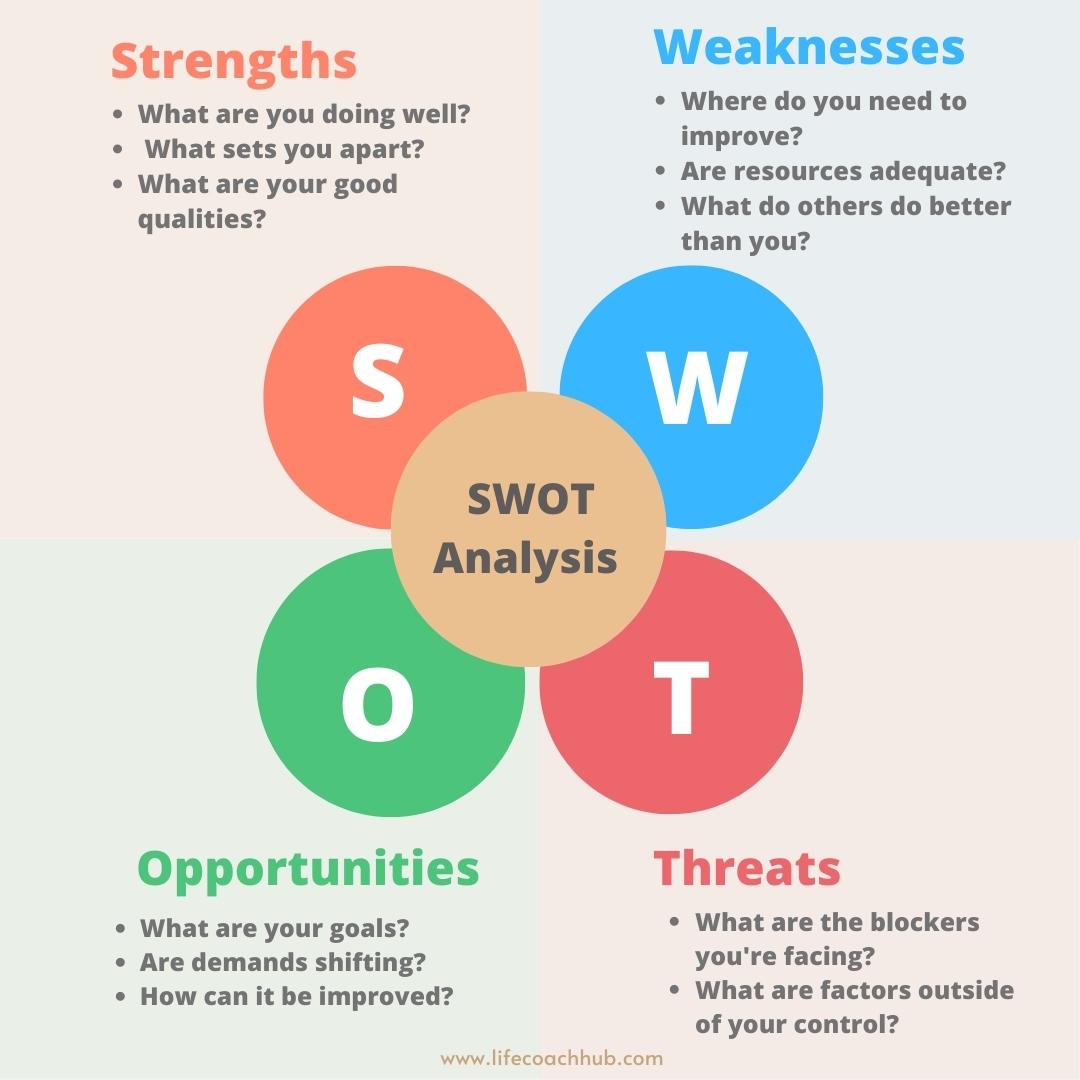
Perform an environmental scan of external factors
For many, a SWOT analysis is already a given when you start a business. But how certain are you of how to use it?
It’s usual to launch into a SWOT by starting with Strengths, then Weaknesses, and finally moving on to Opportunities and Threats. But a Harvard Business Review article recently shed light on making the SWOT analysis work better (Minsky & Aron, 2021). It turns out there’s a clever way to apply it in your company. That’s by performing it backward, starting with the opportunities and threats.
Do a quick environmental scan and examine the market trends. Find out how the coaching industry has changed within the past few years. Are there more opportunities in coaching even after the global pandemic? Also, assess the threats in the industry and identify how you can overcome them.
This way, you’ll get ahead of the game as you check and address all external factors that can impact your services.
What services do most clients need, and how well are these services available to them? Who are the key players in the industry? Identify what customer groups are attracted to those key players’ offers. Do your research on current coaching products and services. Then assess what’s the most in demand, and what range of services seems most profitable.
This will help you identify the opportunities you can tap into as you develop your coaching business. But what are the possible threats?
Say there are tightened regulations for your coaching company. Think about the extra licenses or documents you need to submit to continue your business. Threats can also come from economic conditions like inflation or recession. As you know, rising product prices lead people to meet their immediate needs first.
Make an honest assessment of internal strengths and weaknesses
At this point, let’s get upfront and personal by identifying your strengths and weaknesses.
Do an honest self-check of the strengths, abilities, interests, and experiences you can bank on as a life coach. It doesn’t have to be as grand as public speaking. But it can be something you can start with and enhance gradually. Say, your deep interest in business or investments. Or previous experience in motivating your team. It can also be your knowledge of forming human relationships.
After your strengths, start uncovering your weaknesses and limitations. Identify your challenges and areas to improve on. For example, you can be a life coach even if you’re an introvert or dread public speaking. But you need to overcome these traits and focus on what you can do better.
The bottom line of your SWOT
Now here’s the bottom line of your SWOT analysis. It must present a path to a performance that goes like this, “Based on the prevailing condition/s (external factor), our ability to (internal factor) leads us to propose that (proposed action),” (Minsky & Aron, 2021).
Here’s how this might apply to a coaching business:
“Based on the existing condition of global inflation, our ability to make our coaching services more accessible and affordable leads us to propose that we offer bundled products and services that are cheaper to serve clients despite this economic environment.”

#3 Focus on your aim
Look closely at the market that you want to serve. Using your SWOT analysis, what can be your best selling point to attract your prospects?
Find your edge
Knowing your abilities and interests, determine in which specific areas of coaching you feel most confident. Look closely at the market that you want to serve. Using your SWOT analysis, what can be your best selling point to attract your prospects?
Although you may have a lot of areas of interest and expertise, it’s best to choose a specific life coaching niche and focus on a distinct target client.
Identify your coaching niche
At this point, list down the top five life coaching topics you prefer. Copy the findings from your SWOT analysis about your coaching client's needs and the typical services they engage with.
Are there life coaching aspects where they intersect? This intersection point of your preferred coaching topic and your client’s needs is your coaching niche.
Niche marketing works both ways. Your client's needs are met when you deliver services. At the same time, your company can be assured of a sale if you target the right customers. Such a method contrasts with offering a general service that doesn’t target a certain group of clients. It’s a “wholesome” attempt to appeal to everyone, but in the end, appeals to none.
Here are more reasons why niche marketing is an effective business strategy.
- Differentiates your service from the ones already available
- Lets you build your reputation and credibility
- Directs your marketing effort to your target clients
- Establishes on which areas to focus, thereby enhancing your expertise
- Ensures your message gets across a specific market
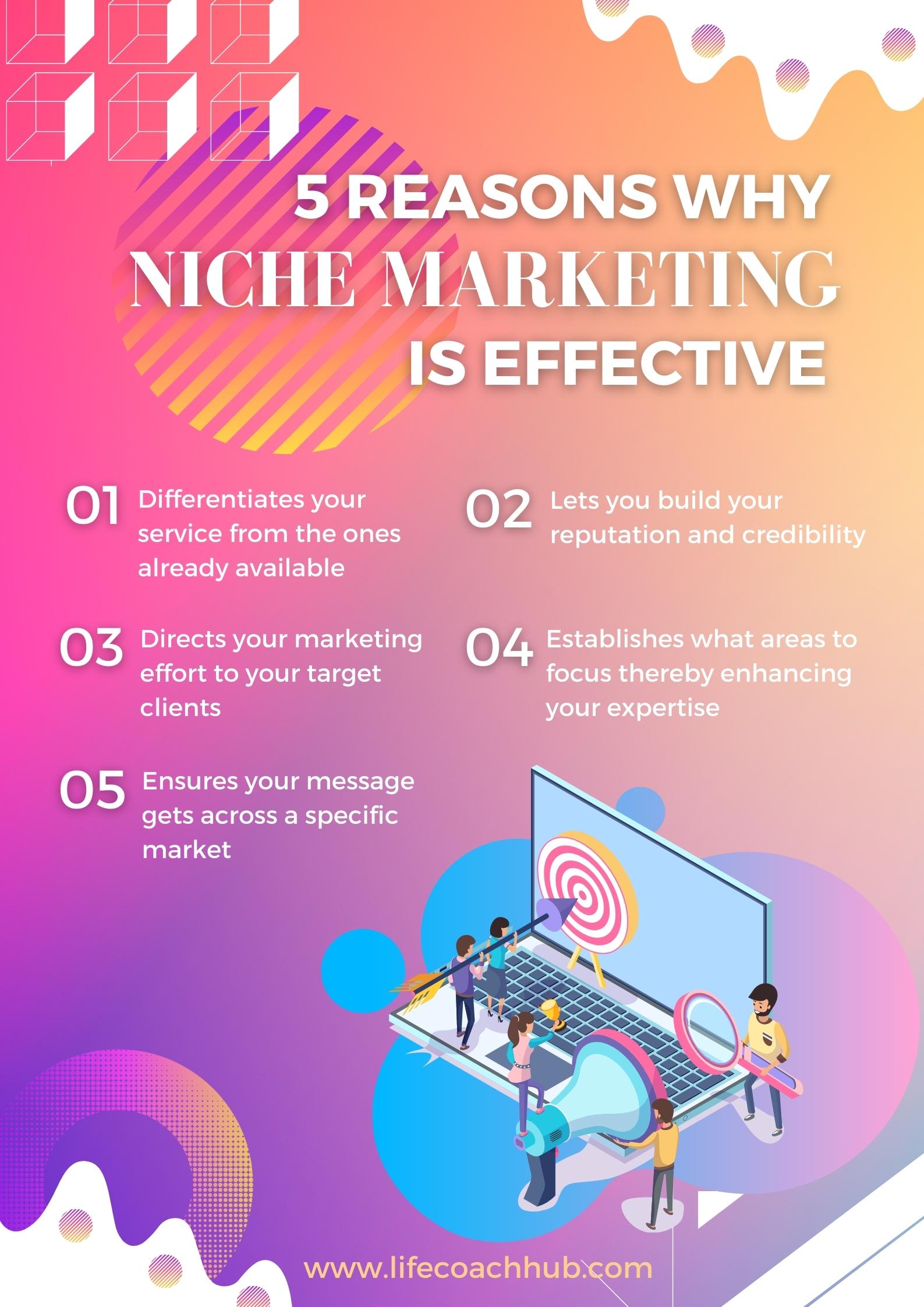
Conduct research on your target client
Niche marketing alone won’t determine the success of your business. You need to go out and examine your target clients through market research before making an offer.
Relying on existing data or studies as your initial findings is only natural when doing your SWOT analysis since you have to base your offer on current market trends and opportunities.
But when you’re already building your brand, you need to conduct your own research. After all, it’s best to have first-hand facts than rely on trends and assumptions.
You can use different market segmentation techniques to categorize your prospects better. Marketers use four common ways to identify their target clients. These segmentation methods are demographics, psychographics, geographic, and behavioral.

Explore your market by conducting surveys, focus group discussions, and in-depth interviews. Check what are your prospects’ attitudes and behavior toward certain coaching services. Diagnose their pain points, understand their preferences, and know about their aspirations.
The key is to be as clear and specific as you can in identifying your target market. You’ll be surprised by the insights you gain from your research. These insights can then lead you to create the right services that address their needs.
#4 Build your brand
The endless pursuit of businesses to sustain their operations only proves one thing. It doesn’t matter how long you've been in the industry; you need to be relentless in building your brand.
Want to know the secret to a successful and sustainable business?
It’s by focusing on your affairs and building a solid brand. Often, we get too overwhelmed when we think too much about competition.
Thoughts like competing against major players and industry giants can seem impossible. But even as a startup, we can level up the game by knowing more about our services and doing the best that we can.
Sadly, startups are the most vulnerable to competition. They are often not well-versed in their market, not to mention having limited resources.
In 2021, data published by the Bureau of Labor Statistics revealed that only 81.6% of startups survived after a year of operation. But, this survival rate is not even that bad. The first-year survival rate among private companies since 1994 falls between 76% to 79%. And this rate gradually drops each year a company is in business, as more private companies experience losses due to poor management and bad business decisions.
The endless pursuit of businesses to sustain their operations only proves one thing. It doesn’t matter how long you've been in the industry; you need to be relentless in building your brand. This persistence calls to be innovative and resourceful in seeking ways to answer your clients’ needs.
Establish your unique value proposition (UVP)
If the problem remains despite available coaching services, there’s still a gap that must be filled. Find that gap and satisfy it through your extraordinary services.
Let’s first do a quick check. You have a coaching niche. You got your research findings. Now you’re set to find a unique offer for your prospects.
What is your unique value proposition (UVP)? Think about a one-of-a-kind and irresistible offer that will appeal to your target clients.
You can imagine it this way:
If the problem remains despite available coaching services, there’s still a gap that must be filled. Find that gap and satisfy it through your extraordinary services.
Choose your starting business model
While crafting your unique value proposition, you’ll get to visualize which coaching methods you’ll use to deliver your services.
Having a coaching business model sets you on the right track. There are many approaches to life coaching. You’ll want to adopt a business model that works best for you and your clients’ needs. Read more about this in our article on choosing a coaching business model.
Craft a compelling coaching package
Attract and convert your prospects through an irresistible coaching package! Prepare various packages with rates and service options to choose from.
Here’s a tip. Try to create 3 to 5 coaching packages. Why? It turns out it’s a clever way to let your clients choose. It allows them to compare packages without getting a headache. Providing two options would be too few while giving six or more choices can cause mental clutter or confusion.
Decide on your business name
What’s in a name?

When I was younger, I often wondered why it was common for actors to change their names. I thought back then that famous personalities who changed their names just didn’t like how their parents named them.
But now I realize how influential names can be. Your name can captivate or disenchant clients. Adding to that pressure is that life coaches must uphold their brand and reputation as a company. At the same time, they also need to establish their identity and market positioning.
Do you have a business name in mind? Or are you still carefully thinking it through?
Here are 5 tricks to help you land a business name that’s right for you.
- Keep it short and clear. Having a catchy name is brilliant, but don’t let your prospects get confused just because it sounds cool.
- Ditch the trend. Play it smart and think of a name that lasts.
- Make it memorable. Put rhythm and rhyme to evoke interest.
- Let it do the talking. Your business name must capture and resonate with your prospects.
- Leave room for growth. Ensure that your name is not too specific in case you expand your business in the future.
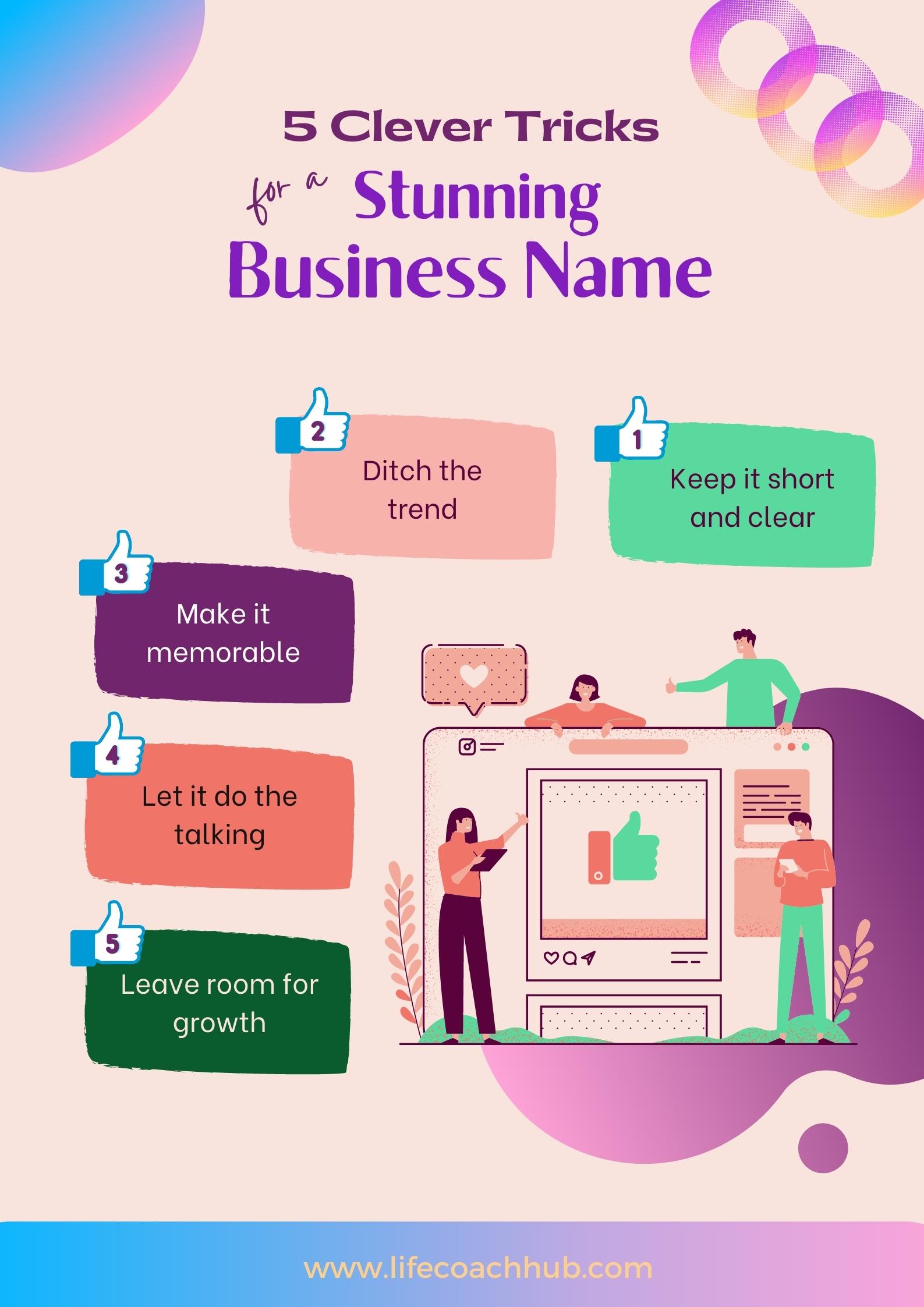
Don’t rush and do your research before finally settling on your business name. Also, ensure that there’s an available trademark and matching domain. That’s once you’ve decided on your company name and before registering your business. Otherwise, all your efforts can go to waste.
Create your brand look, logo, and tagline
Are you feeling creative? Try to picture how you want your logo to appear to achieve an appealing brand look.
After you get some initial concept ideas, getting outside help from a graphic designer is a must-do. You will get a polished final product that way. Don’t sweat it–it’s easy nowadays to hire talent online on platforms such as Fiverr.com
Besides, there’s still more to focus your energy on - such as your tagline. Having a unique and catchy business name paired with an appealing logo isn’t enough to draw engagement. Well, it can attract your prospects, but a greater question stands - is it enough to elicit brand recall?
That’s where taglines come and save the day.
A tagline is a short phrase that communicates your brand’s value. A well-crafted tagline can create a positive and lasting impression in the client’s mind. It acts as a bridge that connects your target clients to your product.
Having a tagline facilitates brand recall among your potential clients. It allows them to easily remember your company by linking what you stand for as a brand.
Here are some of the best taglines of all time. Use them to draw inspiration in creating your own.
- Nike: “Just do it”
- Apple: “Think different”
- M&Ms: “Melts in your mouth, not in your hands.”
- Coca-cola: “Taste the feeling”
- Toyota: “Let’s go places”
#5 The formalities: business structure, registration, and other tasks
You have your target client, a unique service, and a solid brand - you might think you’re ready to get your first client.
Not quite. You’re missing a critical step in starting your coaching business.
Before opening your business, you need to figure out first your business structure, and then register and reserve your business name.
Identify your business structure
Before applying for a business license, first, identify your business structure or form of ownership. Choose a structure that fits well with your business, as it will also be your legal framework and will affect your daily business activities.
Your structure will impact management control, obligations, and tax requirements, so choose wisely. Review your business needs and goals to ensure that your structure will work well for you.
Let’s check out the four common business structures.
- Sole Proprietorship. Simple to create, the least costly to establish, and gives you full control of your business. But its massive disadvantage is your unlimited personal liability as the owner. That means you are liable for all business debts, making it hard to safeguard your hard-earned assets.
- Partnership. When two or more people join forces to co-own a company, they make an easy-to-form partnership. But its downside is that one partner has unlimited personal liability. It also leaves the door open to potential conflict in personality and authority.
- Corporation. Corporations fall into more than one category. The traditional C-Corporation is treated as a separate entity from its owners. So a C corp can make a profit, get taxed, and can be held liable if something goes wrong. This creates a safety net for its owners so they are free from personal liability. However, a corporation can sometimes be subject to double taxation, so some owners choose to form an S corp to avoid getting taxed twice. This is a pass-through corporation, where profits and (some) losses get passed through to the owners.
- Limited Liability Company (LLC). LLCs combine the benefits of corporate and partnership business structures. They protect your personal assets when faced with lawsuits or bankruptcy. Members are considered self-employed, however, and need to pay Medicare, Social Security, and employment taxes.

Get your business license
Check your state laws for more details on how to properly register your business. Also, ask about the validity of your business license. In some states, you must renew your license yearly or present extra documents.
Draft a coaching contract
Protect your company and your client by creating a coaching agreement. Such a contract needs to clearly define your services, price, and obligations. Some coaching software such as ours will provide a coaching agreements template, and even send these out automatically as part of your welcome package.
Ensure that you have all essential matters covered by consulting a reliable attorney. Who knows? Such a move can save you in case something unexpected occurs.
Open a business bank account
It’s often a struggle to track your income and spending. So, starting now, make a conscious effort to separate your business and your personal income and expenses. Open a business checking account and a separate business credit card. Put all business expenses on that card.
As a business owner, the quickest way to check your company's profitability is by looking at your bank statement regularly. Integrate your bank with Quickbooks and check your profit and loss monthly or at least quarterly.
Set up your accounting and bookkeeping practices
You can find various software and accounting systems online. But as a startup, you want to keep your operating expenses low. The good thing is, there’s also not a lot to record at first.
So why not take advantage of your current resources? If Quickbooks is too much of an upfront investment, Excel can do the trick in a pinch.
The key is to build a habit of recording and monitoring your income and expenses and pay the proper taxes.
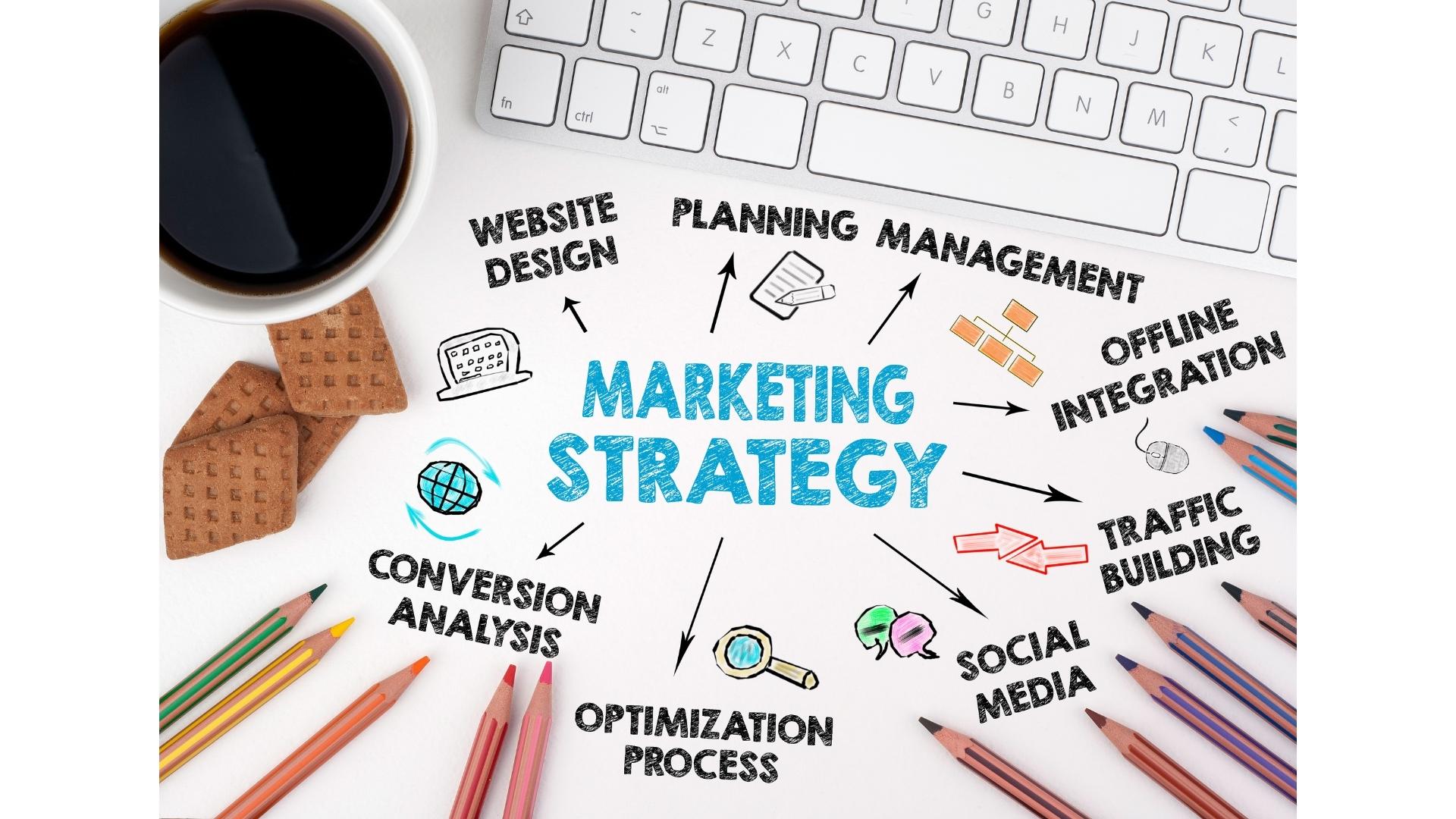
#6 Reach out to your prospects
Whew! Now that you’re done with the paperwork, get ready for the fun part. Start reaching out to your prospects and getting your first coaching clients.
Build your website
It doesn’t matter whether you’re a startup or a large corporation. You need a website to show the world who you are as a brand.
Back when the internet wasn’t as popular, you needed a physical business address to get clients. Almost two decades later, the business landscape has changed drastically. Today, all you need is a website for your customers to reach you at.
It doesn’t matter whether you’re a startup or a large corporation. You need a website to show the world who you are as a brand. Use it to showcase the benefits of your products and services to your target clients.
Web design greatly influences a visitor’s experience since 38% of people say they won’t visit an unattractive site (Miller, 2019). Make sure you have a responsive site as well because 63% of web traffic now arrives via mobile.

Don’t fret about needing to have mad tech skills. There are out of the box coaching website solutions such as the one we offer, tailored for a coaching business. They are super easy to get set up and have you online in no time.
Having a great website can boost your conversion in seven pivotal ways:
- Employs nonstop (24/7) marketing
- Positions your company as a brand with authority
- Attracts organic leads without much cost
- Engages visitors through appealing web design and unique user experience
- Builds a solid tribe
- Secures your published content and grown advocates
- Enhances networking opportunities
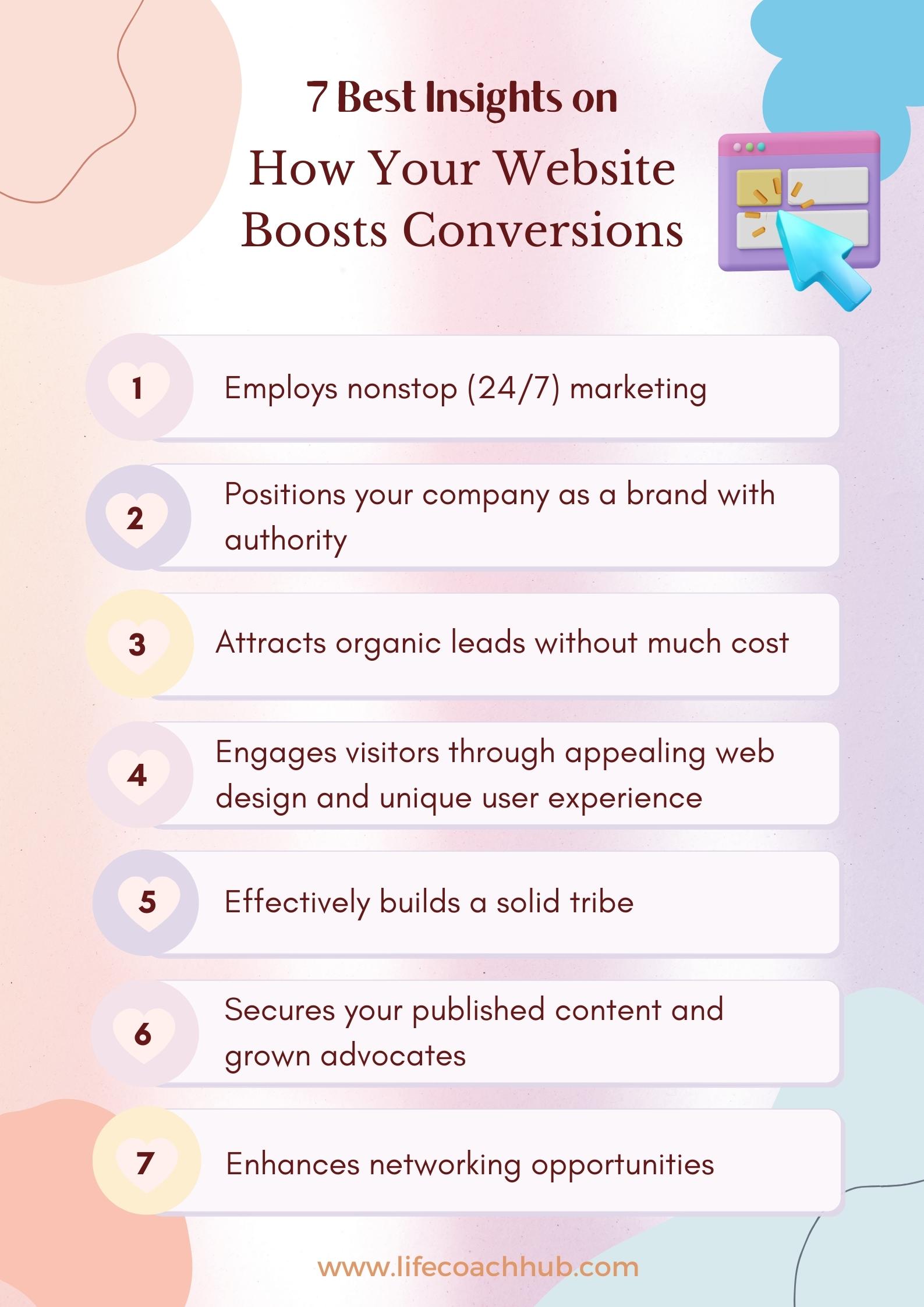
Create social media accounts
Let’s go back to the target clients you identified in Step 3. Were you able to figure out which social media platforms your prospects use?
If they are working professionals, you might want to start with LinkedIn. Then build your audience from there. Go on to explore other social media platforms like Facebook Groups, Instagram, Pinterest, TikTok, and Twitter.
Gain followers by posting tips and valuable insights that benefit your prospects. You can also directly connect with your audience through a Q&A once in a while.
The bottom line is you should be expanding your use of social media to increase your exposure. Explore various social media platforms to capture and engage your prospects so you can turn them into clients.
Publish high-value content
Set up a content planner as you prepare and publish helpful content.
A content planner is a tool to track your marketing goals, whether it’s to create brand awareness, improve search ranking, or increase conversion. The main part of a content planner is the content calendar. Your content calendar lays out what content to publish, which keywords to target, who will write it, and when it should be published.
By carefully monitoring your content, you can check what resonates with your readers, which can lead your prospects to become your advocates.
Also, consider your research findings from Step 3. Then start creating high-value content which can relieve your prospects’ struggles and worries. Don’t publish just for the sake of it.
Ensure that your content has substance and a powerful call to action to boost your conversions.
Broaden your reach through other marketing techniques
Explore other marketing strategies such as email marketing, podcasting, making quick tutorials, and being visible at networking events.
Exploit word-of-mouth marketing through friends, relatives, former colleagues, and acquaintances. Use the power of referrals from your networks, even from your first coaching clients. Studies prove that it is still the most effective and considered highly reliable.

#7 Streamline operations
Kudos to you for making it this far! As you begin your journey in your new venture, we hope you’ll maintain the zeal and passion for developing others and changing lives.
Select trustworthy service providers
To ensure you give the best services to your clients, only get quality services from trusted brands and suppliers. Keep only those that help your business grow.

Choose a reliable payment system
If there’s an aspect of your business that you need to secure, it’s your payment system. The last thing you want is for your clients to be concerned about your payment options, especially if you choose online coaching as your niche. Trust can be quickly lost. Select a reliable payment system to minimize friction.
Offering your services on a coaching platform like ours will take away the headaches of invoicing and payments, and make sure your customers stay happy.
Create processes and systems you can replicate
You are starting out and may feel overwhelmed, but it’s important to start out right. There may be more work upfront if you invest time into creating systems, but you will save a ton of time and money in the long term.
What do we mean by systems and processes?
Well, let’s take client onboarding as an example. Instead of having a dozen different emails you need to send manually, set up a system where everything will be emailed out in an efficient order. The welcome package, the agreement, and the collection of client personal and coaching data.
What about appointments? Is your coaching plan sent out automatically? Is rescheduling handled seamlessly? All these aspects and more of your coaching are ongoing, mundane tasks that you should not have to keep replicating.
A coaching software platform like ours will make everything run seamlessly with zero effort on your part after the initial set-up, so it’s a must-have for any coach.
Start to create programs that move your business model away from fee-for-service
The fee-for-service business model is the essence of coaching. Fee-for-service means that for every hour you spend coaching, you get paid. But you only get paid for the hours you are coaching. That’s why it’s also the most time-consuming and least scalable coaching business model.
After you get into the swing of handling your coaching through one-on-one and group coaching appointments, it’s time to start diversifying.
You could start by creating some set-and-forget courses, some e-books, and other products and services that are less hands-on and can help you bring in multiple streams of income. Read more in our article about coaching business models. Our coaching software is set up to help you diversify in all these ways.
#8 Assemble your team
Are you starting to get too busy? This step is really for the intermediate phase of your business instead of the start-up phase, but we wanted to give you a preview of how you can really start to scale.
As more prospects turn into actual paying clients, it becomes challenging to perform all your business functions. Gather support by forming a reliable team. Free yourself from juggling tasks like making client appointments, marketing, creating quality content, and bookkeeping.

Thanks to the internet, nearly everything is possible online, including hiring a virtual team. But for this setup to work for you, you need to create a clear structure. Establish specific job roles and expectations, and create ways to communicate openly.
Virtual Assistant
Want to free yourself of the minutiae of administering your coaching company? Hire a dependable virtual assistant first. Check out Upwork.com and Onlinejobs.ph. You could also post an ad on Craigslist.
Get real with the responsibilities and expectations the job entails in your job posting. Select your magic 10 applicants, then set up an interview schedule in one go.
Social Media Planner
Hiring someone to post your social media content and respond to clients can free up time once you start getting more popular.
Content Writers/ Graphic Designers
Investing in high-value content for your blog will attract and engage your prospects. Once you have some revenue to reinvest back into your business, it could pay off to hire skillful writers and graphic designers to elevate your website content and appeal.
Accountant/ Bookkeeper
As business owners, we all want our company to grow. But managing finance is not in everyone’s wheelhouse. Get yourself a knowledgeable and trustworthy accountant.
Hiring an accountant can give you clarity in recording your income and expenses to avoid future problems. If you’re lucky, they can even help you find ways to scale your business. They also make good partners when preparing for investment decisions.
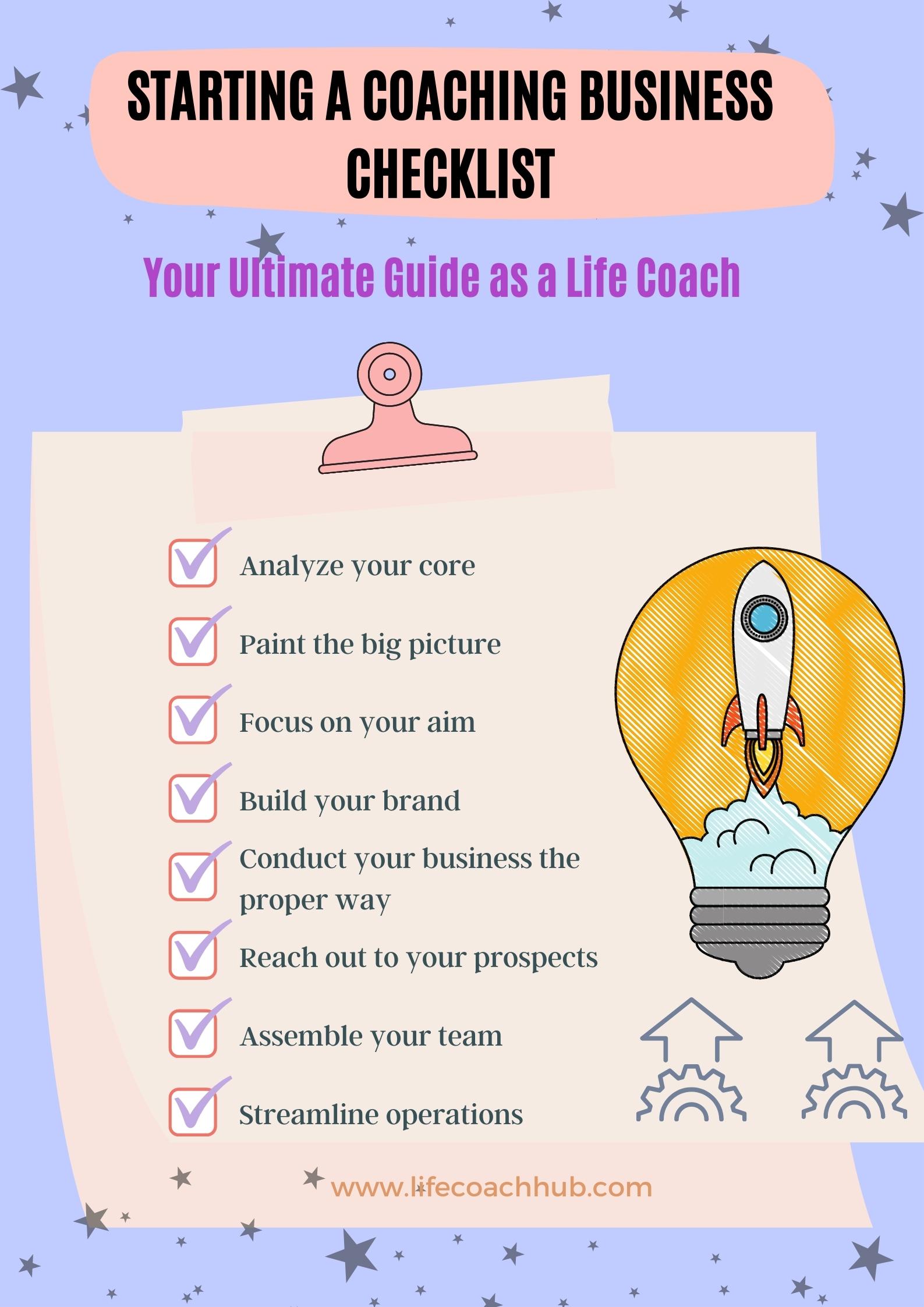
Other resources for starting your coaching business
Though it seems like a long road ahead, having this coaching business checklist as your ultimate guide can gear you up to achieving your purpose. Continue to thrive as a life coach!
Check out these additional coaching business resources:
Coaching business plan guide: Get help with crafting your business plan.
Start off right and save tons of time and money long term by choosing the right coaching software for your business. Create amazing value for your clients with forms, worksheets and coaching tools that will keep them coming back for more.
Don’t forget about marketing:
List yourself in a Coaching Directory: Be visible to people looking for coaches with a free coach directory listing.
Write a compelling Coaching Bio: While you are at it, make sure you create an awesome coaching bio that attracts clients.
Marketing Plan Guide: Top tips on creating a marketing plan as a coach. Get your business off to the right start with a solid marketing plan
Marketing Strategy Guide: More tips for brilliant coach marketing strategy– Top 7 Life Coach Marketing Strategies (Go Get Those Clients!); 20 Unique Tips for Your Marketing Strategy
Social Media guides: Reach online mastery with 5 Tricks to Combine Social Media and Your Coaching Business Successfully and the Ultimate Social Media Strategy for Coaches
Help getting your first clients:
Get your first coaching clients with this simple plan: How To Get Your First Coaching Clients: 3-Step Plan
Guide to getting coaching clients: 5 Keys For How to Attract your Dream Client as a Life Coach (Crushing it Guide)
AND MORE
And don't forget to sign up for a free directory listing, client leads, and coaching software to administer your coaching seamlessly to clients.
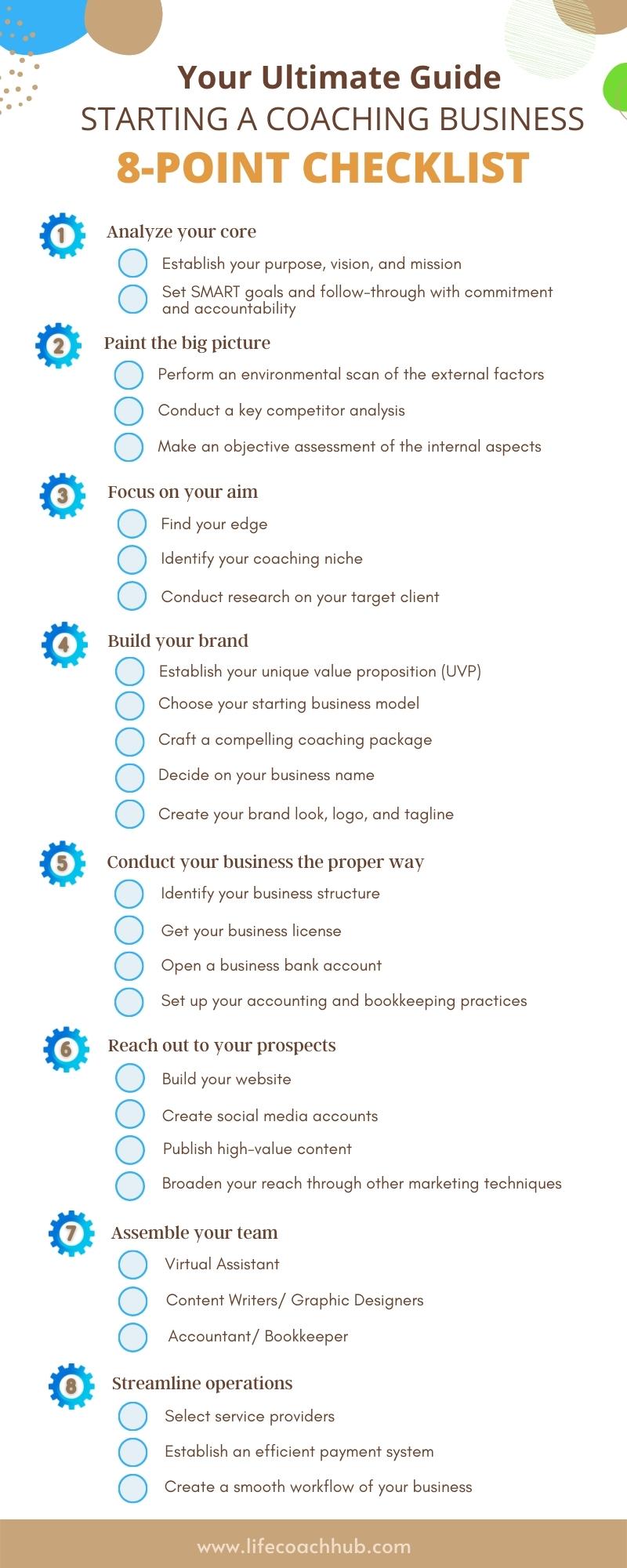




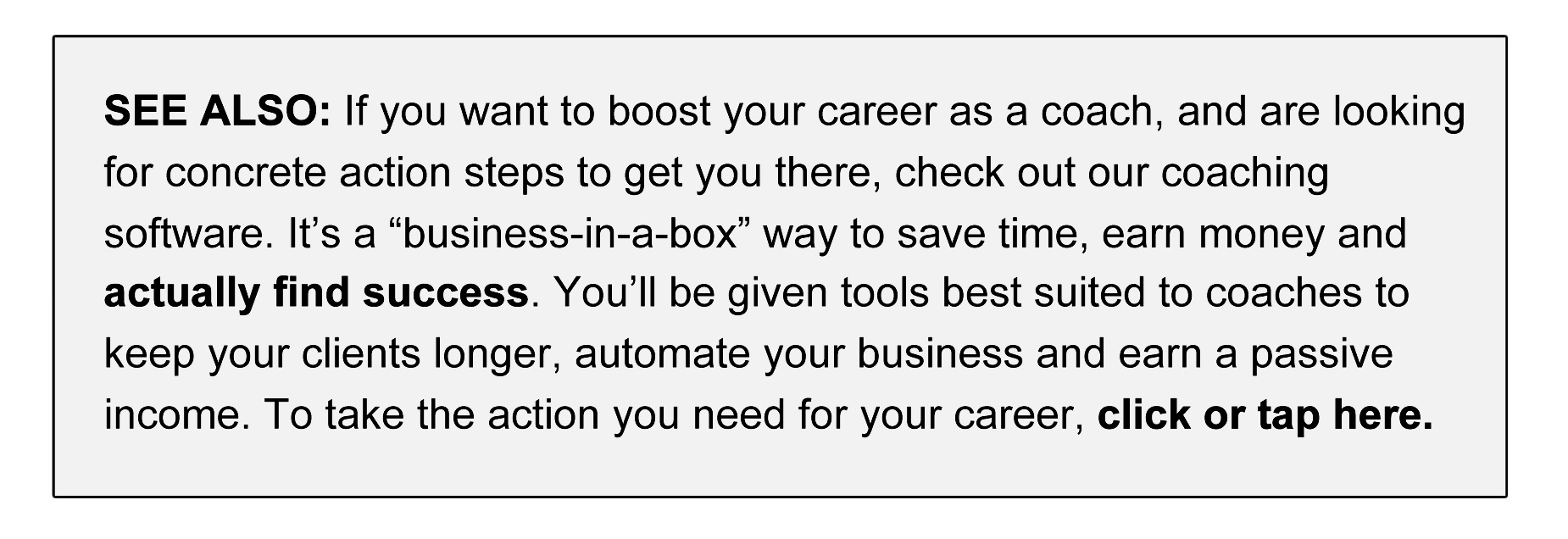















COMMENTS